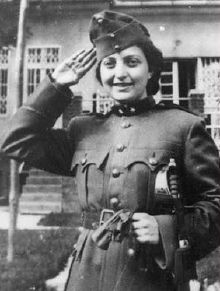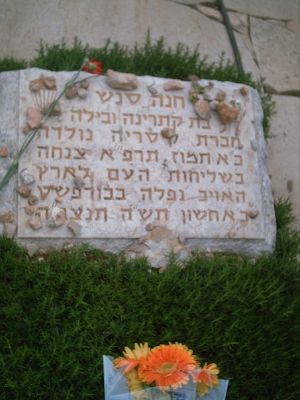Hannah Szenes
THIS ARTICLE IS BEING WORKED ON, JANUARY 2007. THANKS! Hannah Szenes (or Chana Senesh) (July 17, 1921 — November 7, 1944) was a Hungarian Jew, one of 17 Jews living in what was then the British Mandate of Palestine, now Israel, who were trained by the British army to parachute into Yugoslavia during the Second World War in order to help save the Jews of Hungary, who were about to be deported to the German death camp at Auschwitz. [1]
Szenes was arrested at the Hungarian border, imprisoned and tortured, but she refused to reveal details of her mission, and was eventually tried and executed by firing squad. [1] She is regarded as a national heroine in Israel, where streets are named after her and her poetry is widely known.
Early life
Szenes was born to an assimilated Jewish family in Hungary. Her father, Béla, a journalist and playwright, died when she was six years old. She continued to live with her mother, Katherine, and her brother, Giora.
She enrolled in a Protestant private school for girls, that accepted – for increased tuition – Catholic and Jewish pupils. However, when she was elected to the school's literary society, she was unable to take office due to the anti-Semitic atmosphere. This, along with the realization that the situation of the Jews in Hungary was becoming precarious, prompted Szenes to embrace Judaism. She announced to her friends that she had become a Jew, [1] and joined Maccabea, a Hungarian Zionist students organization.
Move to Nahalal
Szenes graduated in 1939 and decided to emigrate to what was then the British Mandate of Palestine in order to study in the Girls' Agricultural School at Nahalal. In 1941, she joined Kibbutz Sedot Yam and then joined the Haganah, the paramilitary group that laid the foundation of the Israel Defense Forces. In 1943, she enlisted in the British army and began her training in Egypt as a paratrooper for the British Special Operations Executive (SOE).
Arrest and torture
In March 1944, she and two male colleagues, Joel Palgi and Peretz Goldstein, [1] were parachuted into Yugoslavia and joined a partisan group. After landing, they learned the Germans had already invaded Hungary, so the men decided to call off the mission as too dangerous. [1] Szenes continued alone and headed for the Hungarian border. At the border, she was arrested by Hungarian gendarmes, who found the British military transmitter she was carrying, which was to be used to communicate with the SOE and with other partisans. She was taken to a prison in Budapest, tied to a chair, stripped, then whipped and clubbed for several hours. The guards wanted to know the code for her transmitter so they could find out who the other parachutists were. She did not tell them, even when they brought her mother into the cell and threatened to torture her too. [1]
While in jail, Szenes used a mirror to flash signals out of the window to the Jewish prisoners in other cells, and communicated with them using large cut-out letters in Hebrew that she placed in her window one at a time, and by drawing the Magen David in the dust. She tried to keep their spirits up by singing.
Trial and execution
She was tried for treason on October 28, 1944. There was an eight-day postponment to give the judges more time to find a verdict, followed by another postponment, this one due to the appointment of a new Judge Advocate. She was executed by a firing squad before the judges had returned a verdict. She kept diary entries until her last day, November 7, 1944. One of them read: "In the month of July, I shall be twenty-three/I played a number in a game/The dice have rolled. I have lost," and another: "I loved the warm sunlight." [1]
Her diary was published in Hebrew in 1946. Her remains were brought to Israel in 1950 and buried in the cemetery on Mount Herzl, Jerusalem.
After the Cold War, a Hungarian military court officially exonerated her. Her kin in Israel were informed on November 5, 1993.
Poetry and plays
Szenes was a poet and playwright writing both in Hungarian and Hebrew. The following are four of her better known poems or songs. The best known of these is Halikha LeKesariya ("A Walk to Caesarea"), commonly known as Eli, Eli ("My God, My God"). Many singers have sung it; it was used to close some versions of the film Schindler's List:
- My God, My God, I pray that these things never end,
- The sand and the sea,
- The rush of the waters,
- The crash of the Heavens,
- The prayer of Man.
- אלי, אלי, שלא יגמר לעולם
- החול והים
- רישרוש של המים
- ברק השמים
- תפילת האדם
- The voice called, and I went.
- I went, because the voice called.
The following lines are the last song she wrote after she was parachuted into a partisan camp in Yugoslavia:
- Blessed is the match consumed in kindling flame.
- Blessed is the flame that burns in the secret fastness of the heart.
- Blessed is the heart with strength to stop its beating for honor's sake.
- Blessed is the match consumed in kindling flame.
The following lines were found in Hanna's death cell after her execution:
- One - two - three... eight feet long
- Two strides across, the rest is dark...
- Life is a fleeting question mark
- One - two - three... maybe another week.
- Or the next month may still find me here,
- But death, I feel is very near.
- I could have been 23 next July
- I gambled on what mattered most, the dice were cast. I lost.
See also
- Rudolf Kastner
- Rudolf Vrba
Notes
Further reading
- Hannah Senesh Legacy foundation
- Jewish Community Day School, Brooklyn, New York
Credits
New World Encyclopedia writers and editors rewrote and completed the Wikipedia article in accordance with New World Encyclopedia standards. This article abides by terms of the Creative Commons CC-by-sa 3.0 License (CC-by-sa), which may be used and disseminated with proper attribution. Credit is due under the terms of this license that can reference both the New World Encyclopedia contributors and the selfless volunteer contributors of the Wikimedia Foundation. To cite this article click here for a list of acceptable citing formats.The history of earlier contributions by wikipedians is accessible to researchers here:
The history of this article since it was imported to New World Encyclopedia:
Note: Some restrictions may apply to use of individual images which are separately licensed.

